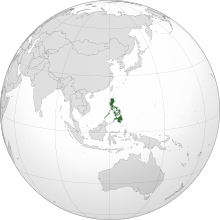
Back معاملة المثليين في الفلبين Arabic LGBT práva na Filipínách Czech Homosexualität auf den Philippinen German Diversidad sexual en Filipinas Spanish Droits LGBT aux Philippines French זכויות להט"ב בפיליפינים HE Hak LGBT di Filipina ID Diritti LGBT nelle Filippine Italian フィリピンにおけるLGBTの権利 Japanese Perkahwinan sama-jantina di Filipina Malay
LGBT rights in the Philippines | |
|---|---|
 Philippines | |
| Status | Legal |
| Gender identity | Transgender people are not allowed to change legal gender |
| Military | Gay, lesbian, bisexual and transgender people allowed to serve openly since 2009; Some restrictions on gender expression based on legal gender (ie. uniform) |
| Discrimination protections | None at the national level, but many anti-discrimination ordinances exist at the local government level in some parts of the country |
| Family rights | |
| Recognition of relationships | None; same-sex civil union bills pending[1][2] |
| Restrictions | No constitutional prohibition but the Family Code of the Philippines defined marriage as "a permanent special contract union between a man and a woman".[3] |
| Adoption | Single individuals are allowed regardless of sexual orientation, but not for same-sex couples. Single LGBT adopters may sometimes be refused to adopt as unfit under "good moral character" criteria.[4] |
| Part of a series on |
| LGBT rights |
|---|
 |
| Lesbian ∙ Gay ∙ Bisexual ∙ Transgender |
|
|
Lesbian, gay, bisexual and transgender (LGBT) individuals in the Republic of the Philippines have faced many difficulties in their homeland, such as displays of discrimination, prejudice, bigotry, hostility, violence, hatred, abuse, assault, harassment and other forms of anti-LGBT rhetoric. Many LGBT Filipinos are met with mixed attitudes and reactions by their families, friends and others in their communities, as well as professionals, educators, their national public officials, politicians, attorneys and others working for the government and the rest of the general population.
Many individuals, groups and communities in the Philippines have helped LGBT Filipinos in need with LGBT-friendly counseling services and therapy sessions to help them escape dangerous and hostile environments.
Filipino LGBT individuals and groups, their communities, and LGBT allies have worked to promote and encourage social and political justice on a national level. They have engaged in social activism and advocacy based on human rights to pass pro-LGBT legislation on a national scale. LGBT Filipinos also have a higher rate of either developing suicidal ideation or attempting suicide.[5][6]
Many equality bills for LGBT rights in the Philippines have been proposed since the 2000s, including the anti-discriminatory Sexual Orientation and Gender Identity Expression (SOGIE) Equality Bill.[7] Despite failing to pass in the national government, many anti-discrimination ordinances on sexual orientation and gender identity exist in either a province, city, municipality or other locality within the National Capital Region (Metro Manila) in the Philippines, including the country's national capital city, Manila.[8]
Meanwhile, an anti-bullying law includes sexual orientation and gender identity as some of its prohibited grounds.[9]
In 2022, two civil union bills have been refiled and proposed by certain groups of public officials, politicians, lawmakers, lawyers, attorneys and others in the Philippine Congress which seeks to recognize, provide benefits and protection for same-sex couples in the Philippines.[10][11]
As a member of the United Nations, the Philippines is being encouraged by various signatory international covenants to promote all forms of internationally-based universal and fundamental human rights which includes promoting LGBT rights.[12]
Alongside these developments, LGBT movements in the Philippines have been very active and gained some political representation.[13][14]
- ^ "Padilla seeks to institutionalize same-sex union". Inquirer. Retrieved August 23, 2022.
- ^ "Civil partnerships for straight, same-sex couples pushed anew in House". The Philippine Star. Retrieved August 23, 2022.
- ^ "CBCP exec: US should respect PHL law regarding same-sex marriage". GMA News. Retrieved April 6, 2014.
- ^ Abrenica, Jessica; Asuncion, Amabelle; Katigbak, Mona Francesca (June 2001). "Beyond Malakas and Maganda: Re-welcoming the Baybayan into the Filipino Family" (PDF). Philippine Law Journal. Archived from the original (PDF) on June 11, 2016. Retrieved April 24, 2016.
- ^ Suicide Ideaton and Suicide Attempt Among Young Lesbian and Bisexual Filipina Women:Evidence for Disparities in the Philippines by Eric Julian Manalastas
- ^ "Suicide Ideation and Suicide Attempt Among Young Lesbian and Bisexual Filipina Women: Evidence for Disparities in the Philippines". Researchgate.net.
- ^ "TIMELINE: SOGIE equality in the Philippines". RAPPLER. August 28, 2019. Retrieved August 27, 2022.
- ^ Cite error: The named reference
:1was invoked but never defined (see the help page). - ^ Cite error: The named reference
:12was invoked but never defined (see the help page). - ^ Cite error: The named reference
:13was invoked but never defined (see the help page). - ^ Cite error: The named reference
:14was invoked but never defined (see the help page). - ^ UNDP, USAID. Being LGBT in Asia: the Philippines Country Report. (Bangkok: USAID, 2014)
- ^ Cite error: The named reference
firstwas invoked but never defined (see the help page). - ^ Cite error: The named reference
:18was invoked but never defined (see the help page).
© MMXXIII Rich X Search. We shall prevail. All rights reserved. Rich X Search